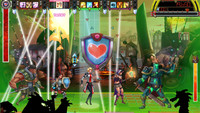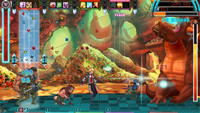|
|

|
PLATFORM
|
PC
|
BATTLE SYSTEM
|

|
INTERACTION
|

|
ORIGINALITY
|

|
STORY
|

|
MUSIC & SOUND
|

|
VISUALS
|

|
CHALLENGE
|
Adjustable
|
COMPLETION TIME
|
Less than 20 Hours
|
|
OVERALL

|
+ Wild mix of RPG strategy and rhythm fun
+ Catchy, multi-genre songs
- Limited story doesn't live up to setting
- Tricky learning curve for Xbox controller
|
Click here for scoring definitions
|
|
|
Rhythm RPGs like Crypt of the Necrodancer and The Metronomicon are like an amazing indie band that sounds like they're making music just for you. Whether they actually are is beyond the point. The connection feels so personal, it's a shame more people aren't doing it. The game is a niche within a niche, taking seemingly familiar ideas and alchemically processing them into something fresh. Puuba's The Metronomicon demonstrates how genre mashups don't have to be the design equivalent of bashing two action figures together and making kissy sounds. Instead, it's an unexpected marriage that teases the best features from its components to create something delightful and new.
Before the high praise continues, it's important to touch on what the game isn't. It's not an RPG for the story-minded crowd. The setting is ripe for exploration, but it'll have to happen somewhere else. This is a fantasy world where trained dance battlers strut their stuff every time a party breaks out, attracting blinged-out monsters who spread destruction and chaos. Unfortunately, the story mode is short enough that the heroes' interactions with monster party culture is more sketched out than developed. The characters are amusing archetypes, but they don't have much going on beyond their funny quips during battle. That's okay! It's all about battles and the music. Stay cool.
Each stage draws on one of the fifty songs from the soundtrack. The tracks focus on beat-heavy electronica and dubstep, however there's also plenty for fans of other genres — especially 80's-inspired synth. Standout tracks include Phonetic Hero's Pubstep, YACHT's I Thought The Future Would be Cooler, Shiny Toy Guns' Live It Up, and the sinister synthwave of Perturbator's She Is Young, She Is Beautiful, She Is Next.
Battles last the length of a song, pitting a party of four heroes against an unending stream of monsters. Survival requires the heroes to use their unique abilities, which are triggered by tapping the moving arrows as they descend from the top of the screen. Notes descend in four lanes, one for each hero. After a character's attack fires off, there's a cooldown period where no notes appear in that character's lane. At this point, it's time to switch to a different hero's lane. The clock is always ticking and enemy attacks pile up.
 Build up a team attack and make it rain.
Build up a team attack and make it rain.
|
|
Each character has three tiers of abilities, which require increasingly long streaks of correct notes to activate. The characters have a variety of abilities that can be assigned to each tier. For example, Wade the fighter can inspire his allies to hit harder, taunt enemies to draw aggro, or make several different types of attacks with his barbell. Depending on which tier each ability is placed, the beat cost and effectiveness improve.
Unlike many rhythm games, success doesn't demand perfection. Note streaks persist throughout lane switches. Ignoring a difficult passage of the song is penalty enough, as enemies will still whale on the party even when no beats are accumulating. Even missing an arrow won't automatically destroy a streak, as long as that character already has enough beats to trigger an ability from an earlier tier. The lesser ability triggers and the streak goes on.
In addition to primary abilities, each character also has several secondary abilities, which fire off after a set streak of party-wide notes. For example, Pierce the thief can choose between stealing experience points every 50 beats or increasing the treasure drop rate every 80 consecutive beats. Ralf the berserker chooses between adding the Bleed status ailment to one incoming enemy every 60 consecutive beats or taking a health-restoring chomp out of an enemy every 55 consecutive beats. The effects and beat costs for secondary effects can be modified with equipment, which is unlocked throughout the story mode.
Choosing appropriate equipment and abilities before each battle is a puzzle that continues once the song begins. Deciding when to use a buff instead of dishing out damage becomes a split-second tactical choice when the arrows start falling fast and furious. As an extra wrinkle, survival isn't the goal for every stage. Arena challenges and sidequests place extra conditions on the battle, including killing a specific number of monsters, killing a boss monster, or simply surviving to the end while under the effect of unremovable status ailments.
 A dragon turns arrows into mines. Yikes!
A dragon turns arrows into mines. Yikes!
|
|
At first it feels like there're a lot of different considerations to track in battle, but it's not necessary to master every subsystem right away. As the difficulty increases, success doesn't depend purely on rhythm reflexes or top-notch RPG strategy, but a unique blend of both. I'm not great at rhythm games, so I started out playing most songs on Easy. After learning a few tricks, I bumped the difficulty up to Medium. Stumbling more often on the note patterns meant taking more fumble damage. On the other hand, it provided more notes to chain together on the higher difficulties. Stumble damage is worth considering, but most damage comes from the hateful enemies. It's a good thing they look so slick!
The art direction, as a whole, is top notch. The world is bright and cartoony, matching the upbeat excitement of the music. The monsters are a memorable crop of misfits. Between the tracksuit-wearing bears, glowstick skeletons, and cosplay seals dressed like Sean Connery's character from Zardoz, the temptation is strong to lose a few battles just to watch the enemies prance about. The floppy animation style, which makes the heroes groove like segmented paper dolls, fits the inhuman monsters even better.
The challenge (and rockability) also depends on what input device is used to play. I started using the shift and arrow keys on the keyboard, but it was too cramped for more complicated beats. The Xbox controller worked much better, but still wasn't ideal. Pressing opposite buttons simultaneously was a dodgy proposition unless I held the controller in an uncomfortable grip. For players who want to be more flamboyant, the game also supports USB dance pads and Rock Band guitars.
There's a lot of replayability in this one. Although the story mode and most of the sidequests can be completed in under twenty hours, play doesn't magically become boring after that point. Puuba is running daily challenges, some of which will have unique rewards. There's also free play for the joy of the dance, global scoreboards for bragging rights, and puzzling arena challenges. More mysteriously, the free play tracklist has an empty section for DLC tracks. No titles have been announced yet, but a free expansion is in the works. Until that seal is broken, the main game is still a great deal. Anyone who's interested in the strategic side of classic RPG combat and isn't afraid of the beat should give The Metronomicon a look.
Review Archives
|









